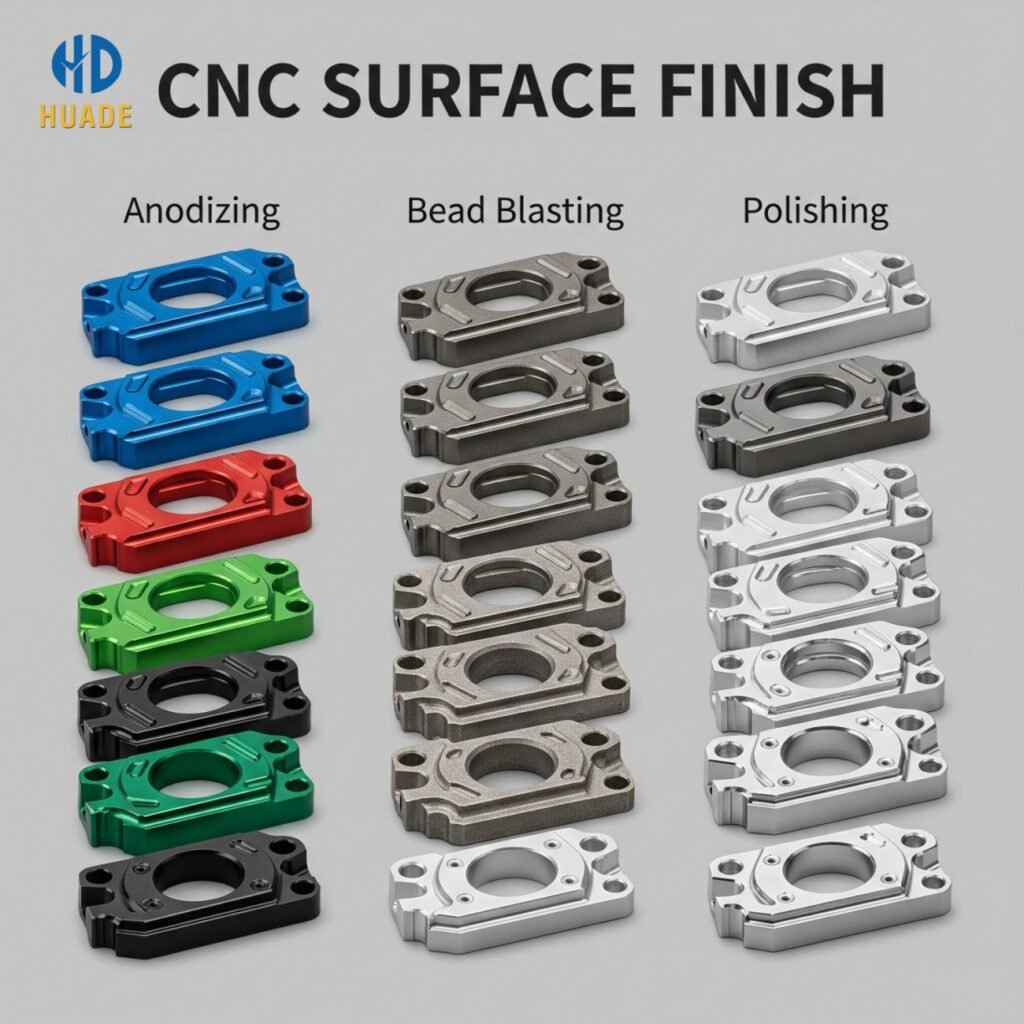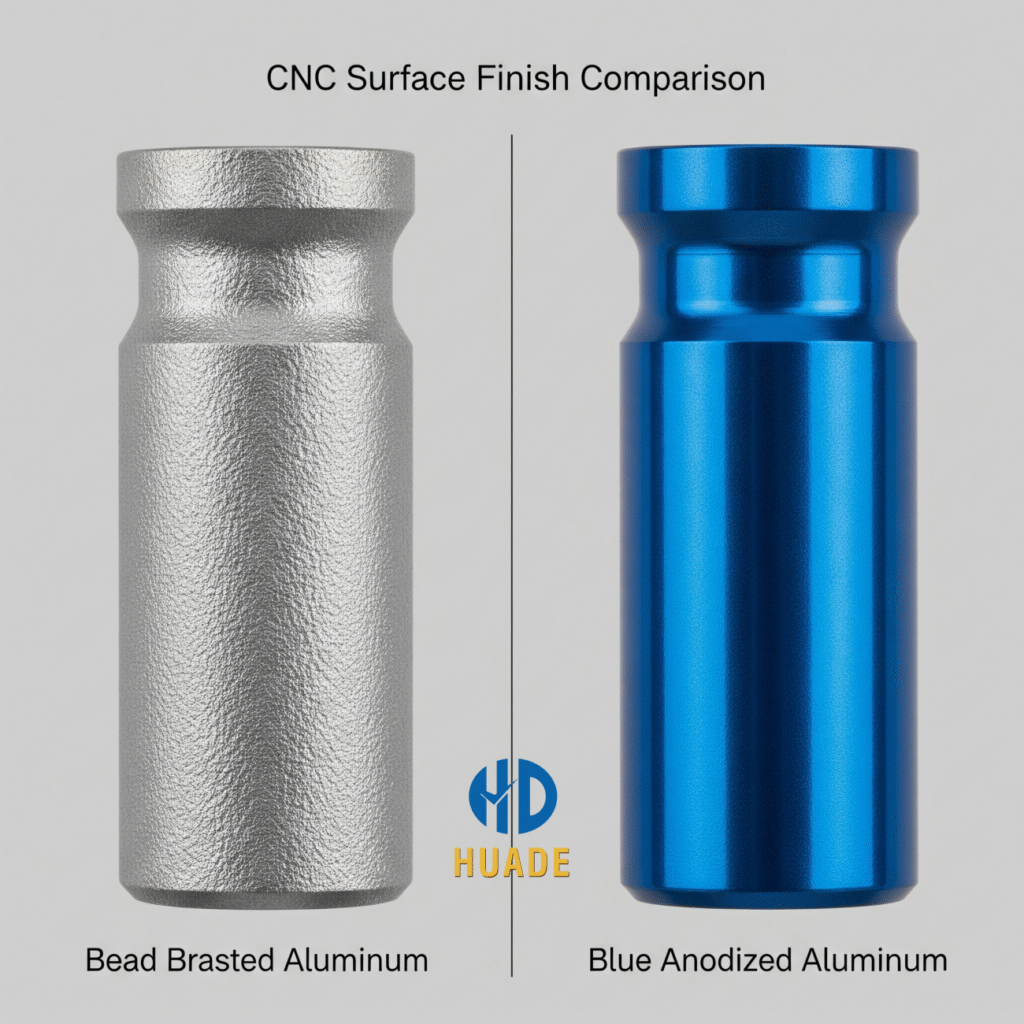
This image provides a visual guide to different CNC surface finish methods. It shows a series of machined parts, each treated with a distinct finish like anodizing for color, bead blasting for a matte texture, and polishing for a high-gloss look. It is an excellent resource for designers and engineers to see how various CNC surface finish options affect the final product’s aesthetics.
You’ve spent hours perfecting your design, selecting the ideal material, and meticulously defining your tolerances. But what happens after the part comes off the CNC machine? The answer lies in the CNC surface finish. This final step in the manufacturing process is often the most overlooked, yet it plays a critical role in a part’s aesthetics, functionality, and longevity. A well-chosen CNC surface finish can transform a raw, utilitarian piece into a polished, high-performance component.
This guide will serve as your ultimate resource for understanding CNC surface finishes. We’ll explore the most common methods, their applications, and the pros and cons of each, empowering you to make an informed decision that will elevate your product from good to exceptional.
What is a CNC Surface Finish?
A surface finish is the final treatment or process applied to a part after it has been machined. The primary goal is to improve the surface properties of the material, which can include:
- Aesthetics: To achieve a specific look and feel, such as a matte texture, a reflective polish, or a vibrant color.
- Functionality: To improve performance by reducing friction, increasing hardness, or ensuring precise fit with mating components.
- Protection: To protect the part from corrosion, wear, and environmental factors.
A part straight from a CNC machine will have a “raw” or “machined” finish, often with visible tool marks. For most applications, this is not sufficient. Choosing the right post-processing method is essential for meeting the product’s end-use requirements.
Key Factors in Choosing a Surface Finish
Selecting the right finish is a balancing act between design intent, material properties, and practical considerations. Before you choose, ask yourself these questions:
- Material Compatibility: Not all finishes work on all materials. Anodizing, for example, is primarily for aluminum, while plating is suitable for a wide range of metals.
- End-Use Environment: Will the part be exposed to harsh chemicals, high humidity, or extreme temperatures? The finish must be durable enough to withstand its operating conditions.
- Aesthetic Requirements: Does the part need to match a specific color or texture?
- Cost and Lead Time: More complex or multi-step finishes will naturally increase both the cost and the time required to complete the project.
A Guide to Common CNC Surface Finishes
Here is a detailed breakdown of the most popular CNC surface finish methods you’ll encounter in prototyping and low-volume production.
1. Bead Blasting
Bead blasting, also known as glass bead blasting, is a process that uses fine glass beads to create a uniform, matte, or satin texture. It is an excellent way to remove tool marks and achieve a non-reflective finish.
- How it Works: A pressurized air gun shoots glass beads at the part’s surface, creating a microscopic, uniform texture. Different bead sizes can be used to achieve varying degrees of smoothness or roughness.
- Pros: Creates a consistent, non-directional finish; hides minor imperfections and tool marks; cost-effective and quick.
- Cons: Can be difficult to clean; not suitable for applications requiring extremely tight tolerances as it removes a small amount of material.
- Best for: Aluminum, stainless steel, and other metals.
- Applications: Consumer electronics, enclosures, aesthetic components.
2. Anodizing
Anodizing is an electrochemical process that forms a durable, corrosion-resistant oxide layer on a metal’s surface. It is primarily used for aluminum and is a very popular choice for prototyping due to its combination of protection and aesthetics.
- How it Works: The aluminum part is submerged in an acidic electrolyte bath, and an electric current is passed through it. This oxidizes the surface, creating a hard, porous layer. The part can then be dyed with vibrant colors before being sealed.
- Pros: Extremely durable and wear-resistant; excellent corrosion protection; provides a beautiful, customizable color finish; maintains part dimensions very well.
- Cons: Only works on aluminum and certain other non-ferrous metals; colors can vary slightly between batches.
- Best for: Aluminum alloys.
- Applications: Electronic housings, aerospace parts, medical devices.

This visual tool highlights the key differences between two popular CNC surface finish methods. On the left, an aluminum part showcases a uniform, matte texture from bead blasting. On the right, the same part demonstrates a vibrant, protective blue anodized finish. This image helps designers choose between a functional, non-reflective finish and a durable, aesthetically pleasing one.
3. Polishing (Sanding)
Polishing involves smoothing the surface of a part using abrasives, often starting with coarse grits and moving to finer ones. The goal is to achieve a very smooth, reflective finish.
- How it Works: The part’s surface is manually or mechanically rubbed with various grades of sandpaper or polishing compounds to remove tool marks and scratches.
- Pros: Can achieve a high-gloss, mirror-like finish; improves dimensional accuracy on mating surfaces.
- Cons: Labor-intensive and costly; does not offer corrosion protection on its own; can affect dimensional tolerances if not done carefully.
- Best for: Stainless steel, brass, and some plastics.
- Applications: Decorative parts, medical instruments, optical components.
4. Plating
Plating is a process where a thin layer of metal is deposited onto a part’s surface to enhance its properties. Common plating materials include nickel, chrome, and zinc.
- How it Works: The part is placed in an electrolyte solution and an electric current is used to deposit a layer of metal ions onto its surface. This process can be electroplating or electroless plating.
- Pros: Adds corrosion resistance and hardness; provides excellent aesthetics; improves wear resistance.
- Cons: Can be expensive; adds a layer of material that can affect tight tolerances; some plating chemicals are hazardous.
- Best for: Steel, copper, brass, and aluminum (with proper pre-treatment).
- Applications: Automotive parts, connectors, industrial machinery.
5. Painting
Painting is a common and versatile finishing method that provides both aesthetic appeal and protection. It allows for a wide range of colors and textures.
- How it Works: The part is cleaned and prepped, then a liquid paint is applied, either by spraying or dipping. The paint is then cured, often with heat, to create a hard, durable layer.
- Pros: Offers extensive color options; provides good corrosion and chemical resistance; can be applied to almost any material.
- Cons: Can be prone to chipping or scratching; adds a layer of material that can affect tolerances; requires careful masking for areas that should not be painted.
- Best for: Aluminum, steel, plastics, and more.
- Applications: Enclosures, consumer goods, automotive panels.
The Ultimate Surface Finish Reference Table
| Finish Method | Key Benefits | Material Compatibility | Cost | Typical Applications |
| Bead Blasting | Uniform matte finish, hides tool marks | Aluminum, Steel | Low | Enclosures, aesthetic parts |
| Anodizing | Excellent corrosion/wear resistance, color options | Aluminum | Medium | Electronic housings, aerospace |
| Polishing | High-gloss, mirror finish | Stainless Steel, Brass | High | Decorative parts, medical tools |
| Plating | Adds hardness, corrosion resistance | Steel, Copper | Medium-High | Automotive, industrial parts |
| Painting | Wide range of colors, good protection | All materials | Medium | Consumer goods, panels |
Conclusion
The choice of a CNC surface finish is a crucial design decision that should not be an afterthought. By understanding the properties, applications, and trade-offs of each method, you can select a finish that not only makes your prototype look professional but also enhances its performance and durability. To learn more about the entire prototyping process, including how materials and design considerations impact your final product, feel free to explore our comprehensive detailed article, The Ultimate Guide to CNC Prototyping.
Contact Us for CNC Surface Finish & Prototyping Solutions
If your project requires CNC Surface Finish expertise or CNC prototyping services, our engineering team is ready to support you from concept to production. Whether you need guidance on selecting the right surface finish for functional or aesthetic purposes, or rapid CNC prototypes to validate your design, we can provide the technical know-how and precision manufacturing to meet your requirements.
At Dongguan Huade Precision Manufacturing Co., Ltd., we specialize in delivering high-quality prototypes with a wide range of finishing options. Our experts are here to help you choose the perfect finish to bring your design to life, ensuring your parts achieve the desired quality, functionality, and appearance.
To learn more about our services or discuss your specific project needs, visit our website at www.hdcncproto.com or send us a direct inquiry through our contact page. Contact us today for a free quote and professional consultation — our team is always ready to help you turn your ideas into reality.
